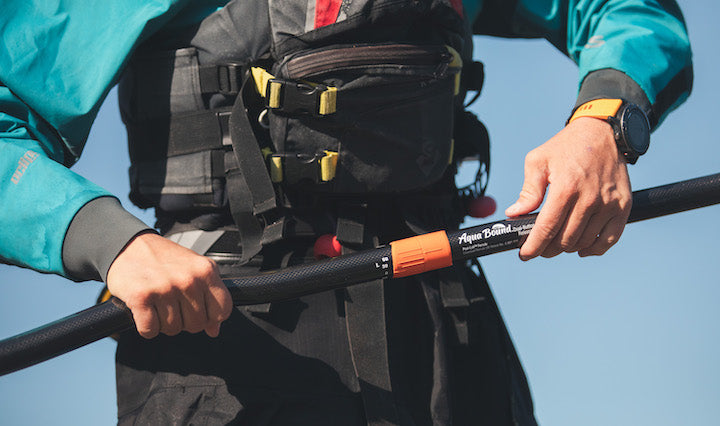All You Need to Know to Choose a Kayak Paddle
8-minute read + 25-minute video
How much do you really need to know about choosing a kayak paddle? More than you think at first glance!

(photo courtesy of Five2Nine)
In the video below, kayaking expert and Aqua Bound Ambassador, Ken Whiting, takes us through the materials, shapes, sizes and costs of kayak paddles. By the end, you’ll have a much better idea how to choose one that best fits you and your paddling needs.
Two Main Types of Kayak Paddles
First, you want to be sure to buy the paddle that’s designed for the broad type of kayaking you plan to do. There are two main types of kayak paddles:
Whitewater Kayak Paddles
Whitewater paddles are designed for power and durability. Power, because whitewater kayakers need to be able to maneuver quickly. Durability, because rivers are strewn with hazards like boulders, rocky bottoms, fallen trees and other items that your paddle will come in contact with.
These paddles are relatively short, generally from 190 cm to 204 cm.
Recreational or Touring Kayak Paddles
These are what most people think about when they picture a kayak paddle. The most common type of recreational paddle features Euro style blades, the kind we make here at Aqua Bound. They’re typically between 210 and 260 cm long.
A less common type of touring paddle is the Greenland paddle. The blades are much longer and narrower, and designed for extreme efficiency over long hours and even days on the water:

A Greenland paddle is the one with the red blade, shown above
How to Choose a Euro Style Blade Kayak Paddle
Blade Shape
Among the Euro style blades, there are two types of blade shapes: High-angle and low-angle. These refer to the style of paddling done with each.
The wider, shorter high-angle blade packs more power, and is best for a vertical, aggressive stroke. The longer, narrower low-angle blade is for more relaxed kayaking, and offers more efficiency over several hours.

Low-angle (left) and high-angle (right) blades are for different paddling styles (photo by Andrew Strain)
Blade Material
There are four main types of blade materials used in kayak paddles:
Nylon blades are the least expensive. But they also have a high degree of flex, which means you lose power with every stroke. So you sacrifice performance for a low price.
Nylon-Reinforced blades are the next step up. These are reinforced with materials like fiberglass and carbon, which increases the stiffness and therefore, the performance. While these can still be easy on the budget, these blades paddle much better than straight nylon blades.
Fiberglass blades are both very light and very stiff, so performance is high. They’re not quite as durable as nylon reinforced fiberglass, although they’re still plenty tough for most paddlers. These will be priced higher.
(It’s with the fiberglass blades that we’re able to handcraft the stunning colors and designs we offer, which is a huge plus for many kayakers.)
Carbon blades are the lightest and thinnest of them all, with plenty of stiffness and durability, too. As you may imagine, they’re also the most expensive.
Differences in Paddle Shafts
Shaft Materials
There are three types of material used to make kayak paddle shafts:
Aluminum shafts are inexpensive, but quite heavy. If your paddle will be used for an hour at a time at the family cabin, that isn’t much of a problem. But if you plan to take your kayak on day trips or even multi-day trips, you’ll want to choose one of the next two instead.
Fiberglass and carbon shafts “are both good upgrades from an aluminum shaft,” says Ken. They’re lighter and provide great stiffness for paddling efficiency. Carbon is, of course, the lighter of the two, and also has the highest price point.

The ferrule system connects the two paddle halves together (photo by of Neil Irwin)
Ferrule System
The connection point between the two halves of a kayak paddle is called the ferrule (kayak paddles are usually made as 2-piece paddles because they’re so long and unwieldy to store and transport).
There are three main types of ferrule systems, although these vary between manufacturers:
Snap button ferrule systems are the most basic and most common type. It’s a simple, cheap connection point to keep costs low. On the other hand, feathering positions are very limited, and they don’t tend to have as snug a fit. In addition, snap buttons can become encrusted with grit or saltwater and stiffen up, making them hard to use.
Locking ferrule systems are designed to reduce or eliminate play in the ferrule. They offer a very snug fit and allow for more customizable feathering, important in windy situations. Our Posi-Lok™ ferrule is an example of a locking ferrule system.
Telescoping ferrule systems offer a range of length (10-15 cm). This is handy in two types of situations: if you’ll paddle more than one type of kayak or if people of different heights will share the same paddle.
Shaft Styles
Kayak paddles come in a couple different shaft styles:
Straight shaft paddles are the most common, and have exactly what it’s name implies: a straight shaft.
Bent shaft paddles help your wrists align better with each stroke. The increased ergonomics is a benefit for many paddlers, especially those who are on the water for hours at a time, have wrist or shoulder issues or love multi-day trips.

Shafts come in both straight and bent styles (photo by Neil Irwin)
What’s the Best Blade/Shaft Combo?
The right combination of blade, ferrule and shaft is really a personal choice. It depends on your paddling style, the type of paddling you do, your body size and your budget.
1, 2 and 4-Piece Kayak Paddles
Kayak paddles come in different piece options to fit kayakers’ different needs and purposes:
1-Piece kayak paddles are popular with kayakers who don’t want any play in their paddle at all. It keeps the shaft as stiff as possible for high performance. They also don’t have the added few ounces of weight of a ferrule system. The only kayak paddles we make in 1-piece are our Shred whitewater kayak paddles.
2-Piece kayak paddles are, by far, the most common. Breaking a long kayak paddle down into two pieces makes transporting and storing much easier than with a 1-piece paddle.
4-Piece kayak paddles are more expensive than 2-piece, but the best for kayakers who want to travel with their paddle. A 4-piece paddle can break down small enough to fit in airplane luggage. The downside is a bit of play with the normal snap button connection points at the blades.
Feathers, Drips and Back-Ups
Paddle Feather
To feather your kayak paddle means to adjust the angle of one of the blades to eliminate wind resistance with the blade that’s out of the water. You won’t need to do this on calm days, but when you’re in high winds, every little bit helps.
Whether or not you feather your blades is a personal choice. But if you often paddle in windy conditions, it’s a nice feature to have a lot of feathering angle options.
Drip Rings
Almost all kayak paddles include drip rings. These are simple rubber stoppers that you can adjust anywhere on the blade. They help prevent paddle drip from making its way down the shaft to your hands. Ken likes to place his drip rings a hand-breadth away from the blades.
Back-up Paddle
If you kayak in a lot of open water like the ocean or the Great Lakes, or in rough water when losing your paddle could be disastrous, a back-up paddle should be high on your must-have list. This is also true for remote conditions and multi-day trips.
Your back-up paddle doesn’t need to be high-end, it just needs to be reliable in case you need it in a pinch.

A well-cared for kayak paddle will last you for years (photo by Andrew Strain)
How to Care for Your Kayak Paddle
Kayak paddles are very low maintenance, but they do require some care:
- Don’t use your paddle to push off from shore. Your paddle isn’t designed to be used as a push pole. The blade—no matter the quality—could snap when used improperly like this.
- Be careful when transporting and storing your paddle. Don’t lay heavy objects on top of your paddle pieces. Don’t shut your vehicle door so it causes impact on the ferrule or blades.
- Separate the paddle pieces after use—especially in saltwater or silty water—and rinse the ferrule system well. This will prevent rust, sticking and scratching inside the ferrule.
For more on this read: How to Keep Your Kayak or SUP Paddle in Tip-Top Shape
Do you have paddle questions our friendly Customer Service Team can help you with today? Contact them: 715-755-3405 • [email protected]
More for you...





